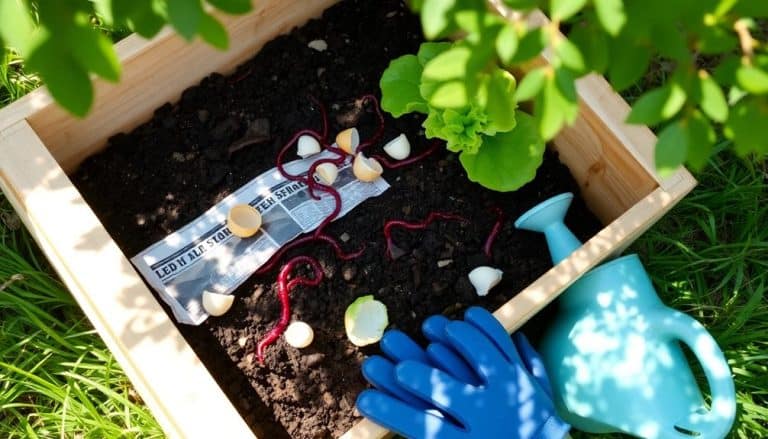This website contains affiliate links. Some products are gifted by the brand to test. As an Amazon Associate, I earn from qualifying purchases. The content on this website was created with the help of AI.
The composting process progresses through four key stages that transform your organic waste into nutrient-rich soil. It begins with the mesophilic stage (20-45°C), where bacteria break down sugars and amino acids over 2-3 days. Next, the thermophilic phase (45-70°C) accelerates decomposition by up to 75% and eliminates pathogens. The cooling phase follows as temperatures drop to 35-45°C, allowing mesophilic organisms to recolonize. Finally, the curing stage stabilizes at ambient temperature, producing dark brown compost with a 15:1-10:1 C:N ratio. Understanding these stages’ specific conditions will help you optimize your composting success.
Key Takeaways
- The composting process begins with the mesophilic stage at 20-45°C, where bacteria break down sugars and amino acids.
- During the thermophilic stage, temperatures rise to 45-70°C as heat-loving bacteria rapidly decompose organic matter.
- The cooling phase follows as temperatures drop to 35-45°C, with mesophilic organisms returning to continue decomposition.
- The final curing stage brings temperatures to ambient levels, producing dark, earthy compost with a 15:1-10:1 C:N ratio.
- Proper moisture (50-60%) and oxygen levels must be maintained throughout all stages for effective composting.
The Mesophilic Stage

The mesophilic stage initiates the composting process when temperatures range between 20-45°C (68-113°F). During this phase, you’ll observe mesophilic microorganisms breaking down readily degradable organic compounds, such as sugars and amino acids. These organisms multiply rapidly, consuming oxygen while producing carbon dioxide, water vapor, and metabolic heat.
As you monitor the process, you’ll notice that the initial decomposition causes the temperature to rise steadily. The population of mesophilic bacteria can double every hour under ideal conditions, which include 50-60% moisture content and proper aeration. These bacteria secrete enzymes that break complex organic molecules into simpler forms.
You’ll find that this stage typically lasts 2-3 days, during which the pH level drops slightly due to organic acid production. The bacterial activity generates heat that gradually raises the pile’s core temperature. Once temperatures exceed 40°C (104°F), the mesophilic microorganisms begin to decline, making way for thermophilic organisms. This shift marks the end of the mesophilic stage and the beginning of the next phase in the composting process.
Active Heating Phase

During active heating, temperatures surge to 45-70°C (113-158°F) as thermophilic microorganisms dominate the decomposition process. You’ll notice this phase typically occurs within 2-3 days after proper pile construction and can last several weeks. The elevated temperatures accelerate organic matter breakdown, with decomposition rates increasing by approximately 50-75% compared to the mesophilic stage.
The thermophilic bacteria’s intense activity creates ideal conditions for breaking down complex materials. You’ll want to monitor these key indicators during this phase:
- Oxygen levels should remain above 5% throughout the pile
- Moisture content must stay between 50-60%
- Carbon-to-nitrogen ratio should maintain 25:1 to 30:1
- Internal temperature shouldn’t exceed 65°C to prevent beneficial microbe die-off
During this stage, you’ll observe rapid degradation of proteins, fats, and complex carbohydrates. The high temperatures effectively sanitize the compost by destroying pathogenic organisms and weed seeds, with 99.9% elimination achieved after sustained exposure above 55°C for 72 hours. You’ll need to maintain proper aeration through regular turning, typically every 3-5 days, to sustain microbial activity and prevent anaerobic conditions.
Thermophilic Composting

Building upon the active heating principles, thermophilic composting represents a specialized method operating consistently at elevated temperatures between 45-70°C (113-158°F). During this phase, you’ll observe thermophilic bacteria taking over the decomposition process, rapidly breaking down proteins, fats, and complex carbohydrates. These bacteria thrive in high-temperature conditions, accelerating organic matter degradation up to 3 times faster than mesophilic composting.
You’ll need to maintain proper oxygen levels (15-20%) and moisture content (50-60%) to support the thermophilic microorganisms’ activity. The heat generated during this stage effectively eliminates pathogens, weed seeds, and plant diseases, with most harmful organisms neutralized after 72 hours at temperatures above 55°C (131°F).
You can monitor the process efficiency by measuring temperature gradients within your compost pile. If you’re noticing temperature fluctuations, you’ll need to adjust aeration through turning or forced ventilation. The thermophilic phase typically lasts 2-3 weeks, though it can extend longer depending on your feedstock composition and environmental conditions. You’ll know this phase is complete when temperatures begin declining despite proper maintenance of moisture and oxygen levels.
Cooling and Curing

Following the thermophilic phase, temperatures gradually decline to 35-45°C (95-113°F) as microbial activity shifts from thermophilic to mesophilic organisms. During this cooling phase, you’ll notice decomposition continuing at a slower rate as mesophilic bacteria recolonize the pile. The organic material’s structure becomes increasingly stable, and you’ll see the original materials becoming less recognizable.
Using a quality starter mix can help accelerate the composting process and ensure optimal microbial activity throughout all stages.
The final curing stage is vital for producing mature compost. You’ll need to monitor these key indicators of proper curing:
- Temperature stabilizes at or near ambient conditions (±2°C)
- C:N ratio decreases to 15:1-10:1
- Oxygen consumption rate drops below 1mg O₂/g volatile solids/day
- Germination index exceeds 90% in bioassays
During curing, complex organic compounds like humic acids form, while potentially phytotoxic compounds degrade. You’ll want to maintain moisture levels between 45-55% and guarantee adequate aeration. The curing phase typically requires 2-6 weeks, though longer periods may enhance compost stability. You can determine completion when the pile maintains a consistent dark brown color and earthy odor, with no traces of the original feedstock visible.
Frequently Asked Questions
Can I Compost in Winter When Temperatures Are Below Freezing?
Like a hibernating bear, your compost pile can remain active even in winter. You’ll need to insulate your pile using straw, leaves, or tarp to maintain internal temperatures above 55°F (13°C) for microbial activity. While decomposition slows considerably below freezing, you can continue adding materials throughout winter. Your pile will resume normal decomposition when temperatures rise. Consider using an enclosed bin or tumbler for better heat retention.
How Do I Prevent Animals From Getting Into My Compost Pile?
You can deter animals from your compost pile by implementing multiple barriers. Use enclosed bins with secure lids, bury food scraps 8-12 inches deep, and maintain a carbon-to-nitrogen ratio of 30:1. Install hardware cloth with ¼-inch mesh underneath to prevent burrowing. Don’t add meat, dairy, or oily foods, which attract scavengers. Regularly turn the pile and spray predator urine around the perimeter for additional protection.
Is It Safe to Compost Materials From Diseased Plants?
Like playing with fire, composting diseased plant materials can be risky. You shouldn’t add plants infected with soil-borne diseases, as most home compost piles don’t reach the 140°F temperature needed to kill pathogens. However, you can compost plants with powdery mildew or leaf spots if your pile maintains 131°F for at least 3 days. Always remove and dispose of severely infected plants in sealed bags.
What’s the Ideal Location to Place a Compost Bin?
Place your compost bin in a partially shaded location with good drainage, maintaining a distance of 2-3 feet from structures. You’ll want level, well-draining soil to prevent water pooling. Select a spot that’s easily accessible year-round but at least 20 feet from living spaces to minimize odor concerns. Consider wind direction and guarantee adequate airflow around the bin to maintain ideal decomposition conditions.
Should I Add Worms to Speed up the Composting Process?
Adding worms can considerably accelerate your composting process by up to 50%. Red wigglers (Eisenia fetida) are most effective, processing up to half their body weight in organic matter daily. You’ll need 1-2 pounds of worms per square foot of bin space. They’ll thrive best in temperatures between 55-77°F (13-25°C) and require consistent moisture levels of 70-80% for ideal decomposition rates.




